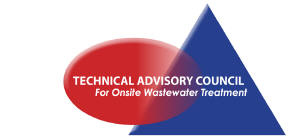

FOR
ONSITE WASTEWATER TREATMENT
Subject: RESIDENTIAL SEPTIC TANK EFFLUENT PUMPING SYSTEMS
CLASSIFICATION FOR WIRING ELECTRICAL EQUIPMENT
The 1995 publication of Standard 820 of the National Fire Protection Association (NFPA) indicates classification changes for residential septic tank effluent pumping systems. NFPA 820, Fire Protection in Wastewater Treatment and Collection Facilities, determines the hazard classification of various types of wastewater treatment and collection systems. Prior to the 1995 edition, residential wet and dry well pumping systems were classified as Class 1, Division 2 environments, due to the possible presence of explosive gases, namely methane. This classification indicates potentially flammable and explosive hazards and would require the use of explosion proof equipment.
Research has demonstrated that residential sewage systems, vented through the home plumbing, adequately vent methane. Therefore, the classification of Residential Septic Tank Effluent Pumping Systems has been changed to unclassified. This is indicated in Table 2 of NFPA 820. This classification does have a restriction in which no more than five dwellings can be served by the sewage pumping system. In other words, systems that serve more than five dwellings are not automatically covered by this unclassified designation.
The Bureau of Construction Codes (BCC) within the Michigan Department of Consumer and Industry Services has since acknowledged the new classification. As unclassified, the electrical wiring requirements are greatly simplified. However, chapters one through four of the National Electrical Code must be adhered to. The BCC also emphasizes the following three points:
1. Flexible cord use must provide for physical protection of the cords.
2. A disconnect must be within sight of the pump motors. Unless the pump control box is located outside of the home within sight of the pump, an additional disconnect will be required at the pump.
3. Wet wells contain hydrogen sulfide, which is corrosive. All electrical components located in the tank or riser over the tank should be of non-corrosive materials—plastic or stainless steel. The conduit between the tank and the pump control box should contain a sealing condulet to keep gases from the control box.
For safety reasons, the TAC adds an additional recommendation to this list. Every pump control box should be kept locked with a padlock or other secure locking device to prevent unauthorized entry.
The Technical Advisory Council presents this advisory to clarify questions regarding the classification of residential septic tank effluent pumping systems only. Since NFPA 820 leaves room for individual interpretation, please contact your local electrical authority prior to design and construction of wastewater treatment and collection systems. If your local authority still questions the issue regarding unclassified residential systems, have them contact the Electrical Division of the BCC at (517) 241-9320.
This informational bulletin was approved for distribution by the Technical Advisory Council for Onsite Wastewater Treatment at their regular meeting on February 13,